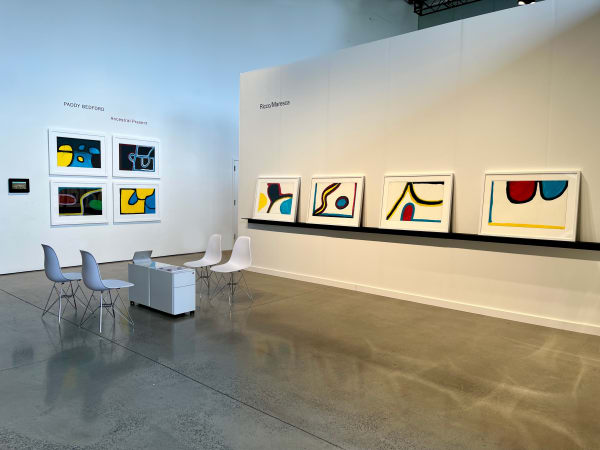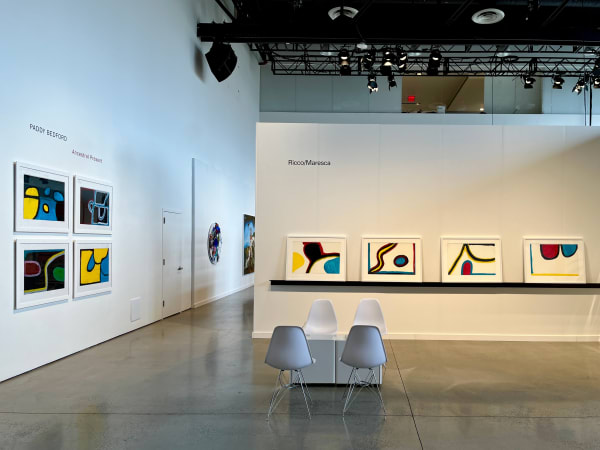Ricco/Maresca is excited to present two concurrent exhibitions of the work of the Australian Indigenous master Paddy Bedford, the first solo shows of the artist to take place in the United States.
Our booth at the Independent Art Fair in New York (May 5 - 8) will include Bedford's works of gouache on board. The gallery exhibition (opening on May 6) will showcase important paintings by the artist.
All photographs of Paddy Bedford © Georges Petitjean 2004
-
Gouaches
All works: Untitled, 2003. Gouache on acid-free crescent board. 20 1/8 x 29 7/8 in. (51 x 76 cm.) | $15,000 ea. -
-

-
Gouaches
All works: Untitled, 2003. Gouache on acid-free crescent board. 20 1/8 x 29 7/8 in. (51 x 76 cm.) | $15,000 ea. -
-
Paddy Bedford—known to family and kin as Nyunkuny, or by his nickname Goowoomji, in his own Gija language—was born around 1922 at Old Bedford Downs Station, southeast of Warmun (Turkey Creek) in the East Kimberley region of Western Australia. In the late 19th century the colonizing pastoralists who came to this area of Gija country named it Bedford. Some years before Nyunkuny’s birth, a massacre of Gija people had occurred at Bedford Downs. A number of the artist’s relatives were poisoned with strychnine in retaliation for killing a cow, and their bodies were subsequently burned.
It was the infamous station manager at the time of the massacre, Paddy Quilty, who gave Nyunkuny his western name, Paddy, at his time of birth. Such were the alienating conditions in which Bedford’s family lived and indeed which most First Nations Australian people experienced in the region known to white settlers at the time as the “last frontier.”
Although it was certainly not the only massacre to have occurred in the region, the memory of this particular event was kept alive by the Gija people and it became a subject in Paddy Bedford’s art. Bedford’s perfectly balanced paintings are rich with multifaceted and intricate layers that address and transcend the brutalities of colonial history. He painted places of great Downs massacre. More explicit than his paintings, though equally commanding, its public performance was a demand for reconciliation on occupied lands—a demand that still resonates from the painted canvas.
-
Gouaches
All works: Untitled, 2003 and 2004. Gouache on acid-free crescent board. 20 1/8 x 29 7/8 in. (51 x 76 cm.) | $15,000 ea. -
-
INDEPENDENT ART FAIR INSTALLATION
-

-
Gouache and Chalk
All works: Untitled, 2003 and 2004. Gouache and chalk on acid-free crescent board. 20 1/8 x 29 7/8 in. (51 x 76 cm. | $15,000 ea. -
-
Although the energy of his gouaches was reminiscent of his paintings on canvas, the smaller scale of the paper determined a dramatic scaling down of his approach. However, these were by no means simply minor versions of larger paintings but something altogether different. By the early 2000s gouache work became a daily part of his painting practice, endlessly variable experiments in form, composition, and color. In these works, neither the white dotting that finished his lines on canvas nor the bestowing of titles by country determined the flight to his play of form.
The large sheets of paper composition board executed in brightly colored water-based gouache—black for the linework, cool red, turquoise blue, lemon yellow, and chalky white, became an exercise in the conception and realization of symbols.
Although seeming like preliminary sketches, Paddy’s gouaches were never scaled up to more extensive works. His great joy in the act of painting can be fully recognized in these works, for they are free of the constraints that attended the specific somber gravity of representation.
Paddy Bedford’s works are complex in the stories they tell. Their compositions, which may seem simple, are never what they seem. A learned and intrinsic knowledge of the land and its creation stories underlies their subtle harmony; physical yet sensitive forms prevail in the paintings. This congruity of powerful physicality and great sensitivity embodies the key to a greater understanding of his work.
-
PAINTINGS
-
GALLERY SHOW INSTALLATION
-
-



















































